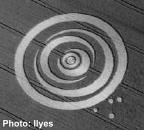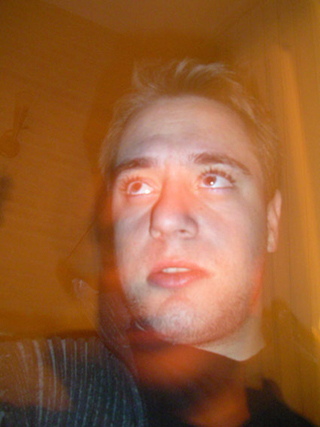 |
| Ambient
light in room has become orangey & sections
of photo appear
doubled.
|
All photos in this report are taken by Robbert v/d Broeke unless
otherwise noted & may not be reproduced without written permission
from him, or the BLT Research Team.
|
Over the years we have noticed a
few fairly consistent alterations in overall ambient light in Robbert's
photographs (and sometimes in mine also) when an episode of photo
anomalies begins. At first we noticed that the overall color in
photos taken inside his home would appear markedly yellow or orangey
in tone, although the walls are mostly white throughout the house.
Also a soft "fuzzed" or out-of-focus effect regularly occurs, sometimes
associated with what looks like a double-exposure in only some
sections of the photograph.
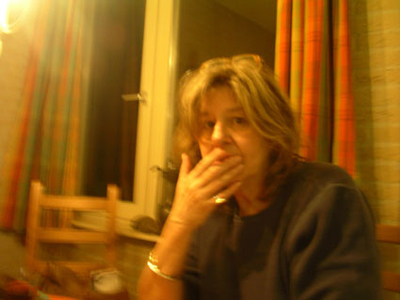 |
| Ambient
light color has taken on a yellowish hue (not actually present).
A whole series of photo anomalies occurred immediately following
this shot. |
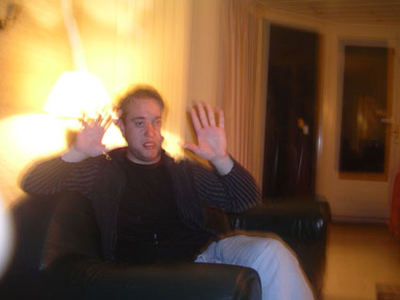 |
| Multiple
distortions, including yellow light and fuzzing or doubling
of most of image,
except for arm of chair closest to the camera. (Photo: N. Talbott) |
We sometimes see this alteration
in ambient-light color in association with either the "smoke" material
or light-balls or both and these photo abnormalities always precede
a whole series of abnormal images, often evolving into much more
dramatic aberrations.
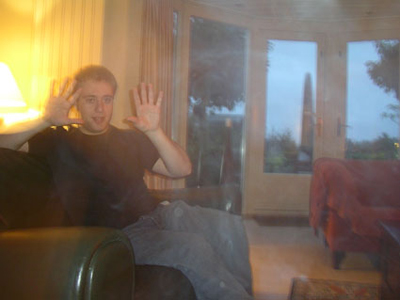 |
| "Smoke,"
light-balls, poor focus & yellowing along left side of
photo.
(Photo: N. Talbott) |
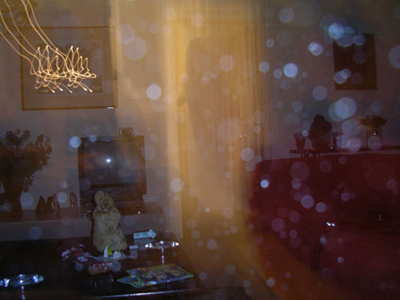 |
| Light stripes
(from ceiling chandelier apparently), BOLs and yellowing of light
in kitchen—and strange figure in doorway. |
In the last 2 years we have begun to see another sort
of ambient light alteration occurring regularly, again always preceding
and/or interspersed with other anomalies. In these instances there
is a darkening of the real ambient light -- and it occurs in photos
taken both inside Robbert's home and in the fields.
Following are a few photos from a long series taken
in Robbert's living room one night in March, 2008. Instead of becoming
more yellow or amber, the ambient light appears much darker than
it really was.
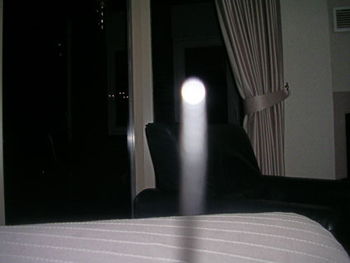 |
| First photo
in series shows light in room to be only slightly darker
than actual lighting. Flash went off on all photos in this
series.
|
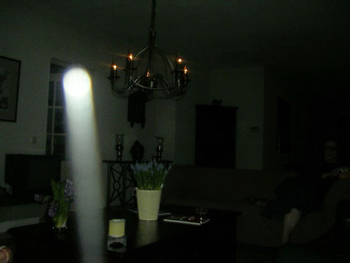 |
| A few shots
later (in spite of chandelier being on & light from camera's
flash) ambient room light now appears much darker than it really
is. |
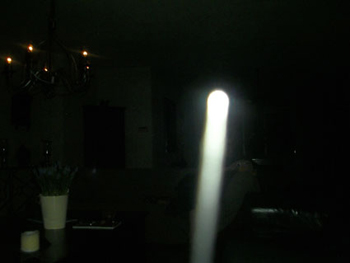 |
| In next
photo ambient light is very dark; Nancy is sitting on sofa
& a
light tube has appeared directly in front of her. |
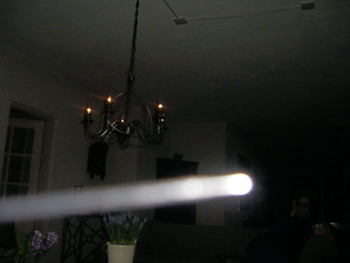 |
| A light
tube now appears to be aimed directly at Nancy, who is still
sitting
on the sofa. Camera's flash, again, did fire. |
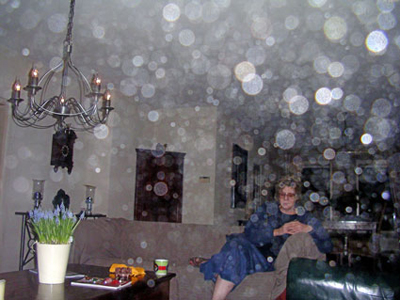 |
| Very next
shot shows room with actual lighting, accented by camera flash --
but many light balls now present. |
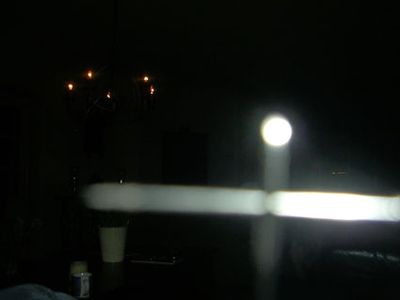 |
| This &
several more shots still very dark but contain bright light
tubes crossed
directly in front of Nancy (light tubes not visible to Robbert or Nancy). |
There are also numerous instances
of these light balls/light tubes occuring when there are no lights
on in the room at all, photos in which the only possible light source
is the camera flash.
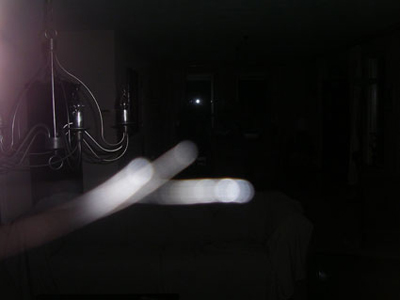 |
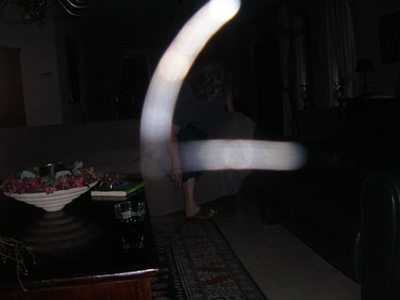 |
| Multiple
light balls/light tubes—with no lights on in room. Ambient
light, however,
is darker than it should be with flash activated.
|
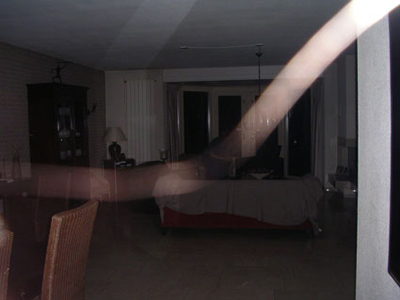 |
| Light tubes
are sometimes colored, usually in pink tones; note corner
of
sofa & other room details highlighted by
light tube. |
Double-Exposure Effect
A photograph taken in 1991 in a field
in England was the first example I had seen of what looked like
a partial double exposure at a crop circle site. John Holman, using
a 35 mm film camera, had taken a photo of a group of people standing
inside a crop formation at West Woods in which the top center section
of the print that containing the crop circle itself and the people
inside it appeared to be a double exposure.
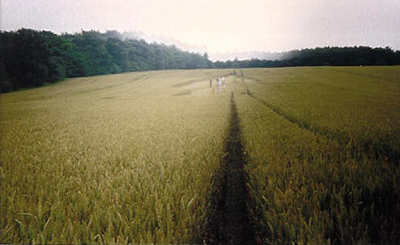 |
| West Woods,
Wiltshire (UK) 1991, with an apparent double-exposure of
top-center portion of photo only. (Photo: John Holman, 35mm film) |
The tree-line behind the field in
this section is clearly printed twice, one line of trees above the
other. The extreme left and right sides of the field and tree-line,
and the lower section closest to the camera, however, are in focus
and appear normal.
Upon closer examination it was clear that not only
was this center section of the print (that containing the crop circle
itself) duplicated, it was also evident that the group of people
standing inside the formation was also replicated but the people
seem to have moved. An analysis of the photo by J. Marshall Dudley
revealed what he determined to be both a "time and space" anomaly,
clearly affecting only this center section of the photograph that
containing the crop circle and the people inside it. For details
of Dudley's analysis see: http://execonn.com/cropcircles/.
In the photos below, taken by Robbert with my Pentax
digital camera during my 2004 visit to Holland, a whole series of
shots show a similar "doubling" effect in parts of the image--although
nothing I can see to indicate a "time" anomaly. In the 2nd and 3rd
photos (below) it almost looks as if the pink-striped comforter
and pillow cover are "reflected" somehow in the air above the couch.
I had the "flu" for the first several days of this
visit and remember that, night after night, Robbert repeatedly took
whole series of anomalous photos which were interspersed with other
groups of perfectly normal shots. During this time-period the bizarre
photographs always contained a yellowish or orangey overall ambient
color, but the normal shots (all taken with the same Pentax) did
not.
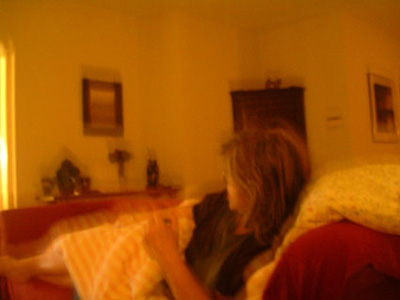 |
| Natural
room light has become yellowish & everything but the lower
right corner
of photo appears to be doubled. |
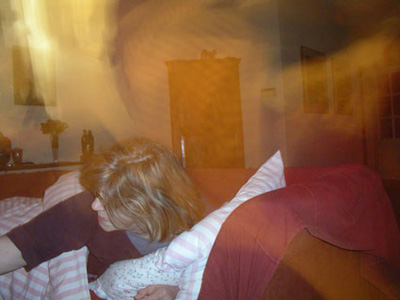 |
| Pink striped
comforter seems to be "reflected" above the couch. |
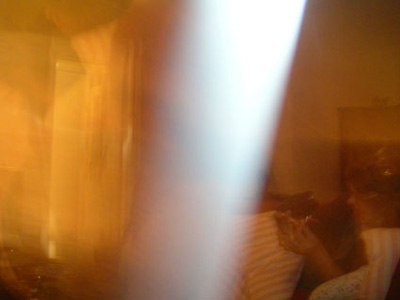 |
| Striped
comforter is duplicated in upper left corner & white "tube"
has appeared. |
Light Streaks
Sometimes, particularly several years
ago when we first noticed the yellowish or orangey ambient light
coloration beginning to occur, subsequent photos would contain light
streaks. Sometimes there were only a few fairly delicate streaks,
in others there were many, both delicate and bold but in the majority
of these photos there was no light source in the room which seems
to be able to account for the streaks.
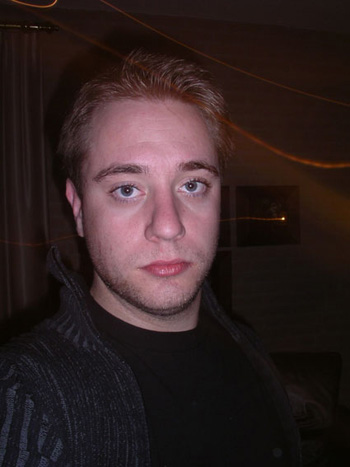 |
| Room is
totally dark what is the light source for the streaks?
And why are they orange? |
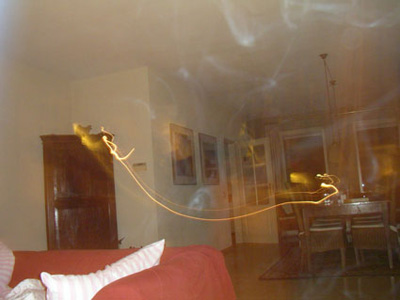 |
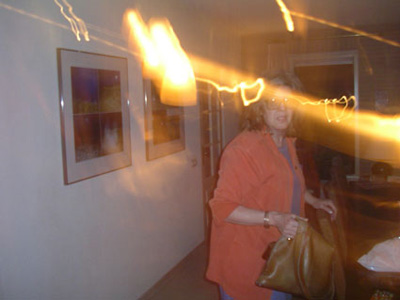 |
| "Smoke"
and streaks, again with no apparent light source. |
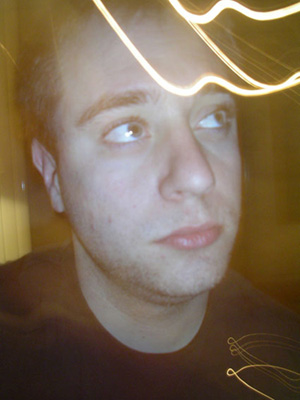 |
| Table lamp
behind Robbert (beyond left of photo) is on—
but not included in frame. |
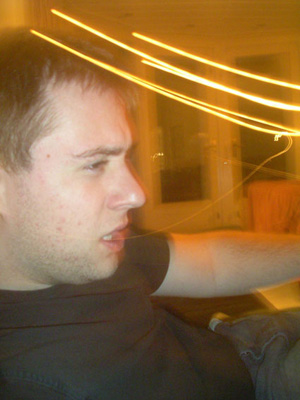 |
| Yellowing
of ambient light & parts of photo out-of-focus;
ceiling chandelier is on, but considerably out of frame on
right. |
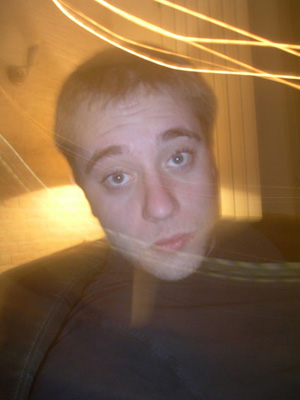 |
| Table lamp
behind Robbert is on, the wall sconce is not.
Chandelier over
coffee table is on, but is considerably
out of the frame,
to the right. |
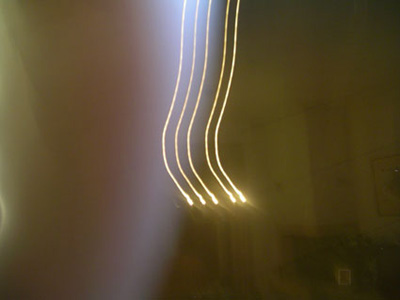 |
| Chandelier
is on, but why is entire image fuzzed & yellowed, & what is
source of
white light-tube which is in front of
chandelier streaks? |
|
Attempts to Replicate Light Streak Photos
A BLT consultant
who holds advanced degrees from MIT in electrical engineering and
solid-state physics and who has considerable experience with both
film and digital photographic analysis has examined some of Robbert's
strange photos for BLT. His efforts have been geared toward demonstrating
how some of these photos could be reproduced.
Using a digital camera in "slow synchro" mode (which
keeps the lens open for at least one to two seconds) he aimed it
in the direction of a street light outside his home. The slow synchro
mode causes unlit objects in front of the camera to be "frozen"
when the flash eventually goes off but--because the street light
is bright enough to cause internal reflections in the camera's optics--the
single street light produces multiple "ghost" images in the photos.
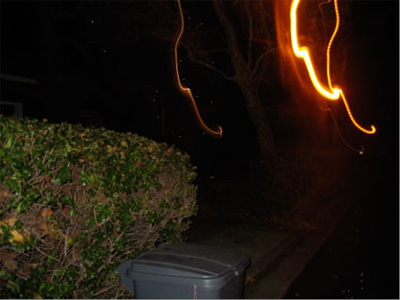 |
| Light streak
replication attempt using camera's "slow synchro" mode.
And why are they orange?
(Photo: BLT Analyst) |
In these examples our analyst has
deliberately moved the camera around in the air during the second
or so that the shutter has remained open prior to the flash going
off, thus producing the apparent movement of the light. And because
the filament in the simulated gas street lamp is flashing about
120 times per second, the light streaks produced by the movement
of the camera appear to be segmented.
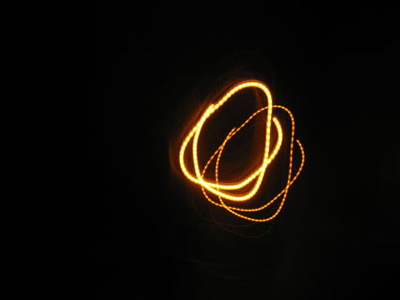 |
| Replication
of light streaks created by bright light source and deliberate
camera
movement while in "Slow Syncho" mode.
(Photo: BLT Analyst) |
Our photographic consultant was
also able to create marked yellowing of the ambient light color
and much fatter light rings in another trial. Again using the "slow
synchro" mode on his digital camera, he focused on the ceiling light in
his kitchen and then rapidly moved the camera around in the air
to create the images. The second photo, below, looks a lot like
some taken by Robbert out in a crop circle field at night (shown
farther on in this report) but, again, the conditions necessary
to create our consultant's images were not
present
when Robbert, using my Pentax, produced similar photos.
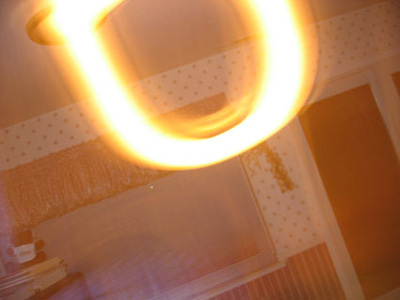 |
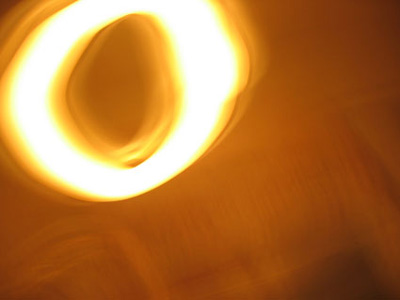 |
| Fat light
rings & yellowing of ambient room light occur when our photographic
analyst aims at ceiling light and rotates digital camera in
"slow synchro" mode.
(Photo: BLT Analyst) |
|
It is helpful to understand how some
of Robbert's photo anomalies could be approximated (so far, our
analyst's duplication attempts have not actually reproduced Robbert's
anomalies). Knowing how similar effects might be
created has allowed me to compare the conditions required by the
analyst to Robbert's actual behavior--what I have seen Robbert do,
and not do.
It is a simple fact that the conditions outlined by
our photo analyst as being required to create his photographs are
not the conditons which existed while Robbert took
the majority of images presented in this report:
- Robbert is using my Pentax &
it is always in the "auto" mode;
- Pentax has a "night portrait"
mode, but it must be set manually;
- Robbert does not
aim (in most cases) at any light source;
- Robbert does not
move the camera around in the air.
The "night portrait" function on the Pentax will, if acvitated, cause the lens to stay open for a second or two prior to the flash going off. But in order to activate this function the "mode" button on the back of the camera must be pushed and then "night portrait" chosen from several options. And, once chosen, a half-moon symbol appears on the LED screen--which will stay there until the option is manually reversed. It takes several seconds to make this change and it also requires good light in which to do it, because the buttons are very small and the display of the various options hard to see.
There are several other facts that must be taken into consideration. Robbert cannot read English the settings on my Pentax are in English. The only times he has had access to my camera have been when I have handed it to him and have then stood right with him while he used it. During the time periods when he has been taking most of the photos presented here I have been quite close to him, and watching.
Also, l have viewed each batch of photos taken by Robbert immediately after he stops shooting and have never seen the "night portrait" symbol on the screen as we scroll back through however many images he has just taken.
I realize that, other than Robbert, I am the only person in the world who can attest to these facts regarding these particular photographs since in most instances only he and I were present. But there are many other people now who have been present on other occasions and witnessed the same or similar events and, in time, their testimony will also surface.
One of the more interesting results of these photographic
trials is that they may provide a real clue as to both the type,
and actual presence, of this "energy" Robbert regularly says is
present. As the Pentax "Operating Manual" clearly states, the camera
"may not function correctly" in situations where strong "magnetic
fields" or "electromagnetic radiation" is present. Perhaps it's
time to seriously consider Robbert's consistent reports in this
regard and begin asking whether this unknown force could be affecting
the operation of, or the settings on, the camera?
Perhaps Robbert is also accurately reporting the fact
that this "energy" is directed through
him from an external presence? If his
intuition is correct in this regard, it would make sense that the
anomalous images occur primarily when the camera is in Robbert's
hands. And if such an unknown energy is present, is it possible
that the camera settings can revert back to "auto" mode or that
the LED display is itself affected?
As we continue with more of Robbert's photos these questions seem more and more reasonable and assaults upon his character or purpose more and more as irrational and emotional responses, combined quite possibly with an inability or unwillingness to see, much less ask, relevant questions.
Segmented White Anomalies
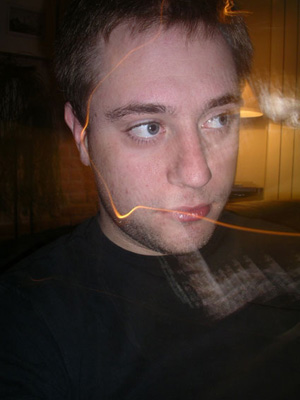 |
| More angular
white anomaly in conjunction
with orange streak. |
Another series of strange images include the presence of a more angular, sometimes racheted, often fairly dense white-colored anomaly which usually occurs in conjunction with the yellow-to-orange ambient light change and light streaks. Often there is what looks to be partial double-exposure and/or superimposition of other parts of the hou
se in these photos.
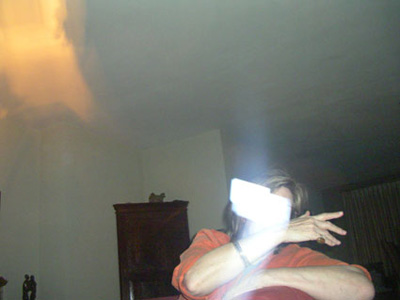 |
| One night
a whole series of close-up photos of Nancy showed these dense
white swaths in front of or near her head. |
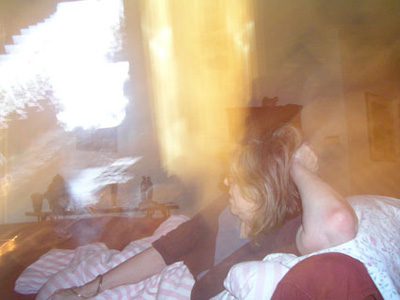 |
| On another
visit some of the white areas appear segmented & one section of
photo appears to be super-imposed. |
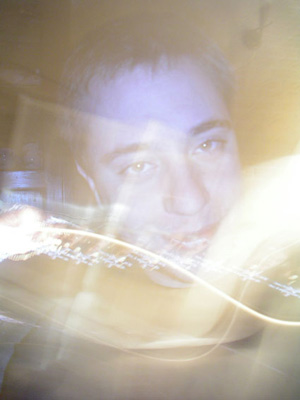 |
| As is often
the case, the light anomalies become very
complex when Robbert aims the camera at himself. |
<< Return to Part 1 | Top | Continue to Part 3 >>
© 2009 BLT Research Team Inc.
All Rights Reserved
photos/illustrations can not be reproduced in any media
except with written permission from the
BLT Research Team
|
|

